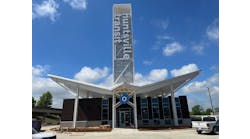Gabriel Morey
Intelligent Transportation Coordinator
DASH
Alexandria, Va. - When the Alexandria Transit Company (DASH) first installed our Clever Devices CAD/AVL system, our goals were simple: meet ADA compliance and dispatch more efficiently. We wanted to meet the public expectation of providing real-time information, but it was a nice-to-have, not a necessity. Now, DASH considers real-time data a core part of our service.
DASH has embraced real-time arrival predictions because they make transit easier to understand and use. Schedules are promises to customers, but they come with caveats outside the agency’s control, especially in a heavy-traffic city like Alexandria. In this environment, real-time predictions do not just inform customers when the bus will arrive—they reassure them that the bus is on the way. Service alerts about schedule changes, detours and stop closures further reduce uncertainty, building trust that DASH will get you to your destination even if your normal stop is closed. However, we have learned that we must post as soon as incidents happen—the usefulness of an alert system is only as strong as staff’s ability to maintain it.
How has a small agency like DASH been able offer such expansive real-time services? First, we took an incremental approach, starting with the DASH Tracker. We have deliberately expanded from there, first with real-time arrival signs and now with the upcoming OneBusAway deployment. We also sought external funding wherever possible, winning grants from the Virginia Department of Rail and Public Transit (DRPT), the Northern Virginia Transportation Commission (NVTC) and the Northern Virginia Transportation Authority (NVTA) that have paid for our digital arrival signs. However, grants are not permanent, so we are launching a signage-leasing program where local business and residential communities can rent signs from DASH. This program will allow business to enjoy the benefits of a sign for less money than buying outright while defraying the costs for DASH.
Finally, we have cultivated relationships that have helped us expand our real-time systems. For instance, Metrobus owns most of the solar-powered signs in Alexandria, but we share resources to purchase, install, monitor and maintain them. The same goes for the LCD displays we’ve installed at local apartments, government offices and the local community college—in each location, we’ve established a memorandum of agreement that shares the cost of the sign.
Transit should be a utility, something as reliable and expected as the water from our tap or electricity from the grid. While real-time data will not unsnarl traffic or reduce dwell time, it reassures customers that they will not be stranded. With creative thinking and slow, steady work, even small agencies like DASH can enjoy the benefits of real-time data.
DASH currently provides real-time predictions in three ways— (1) the web-based DASH Tracker; (2) third-party apps (notably the Transit app); and (3) a network of over 20 solar-powered digital arrival signs jointly-managed by DASH and DC Metro. Going forward, we are launching the DASHBus mobile payment app that links to the Transit app, installing more digital arrival signs and deploying OneBusAway to integrate with Metro’s BusETA. We consider real-time predictions as so vital that we even hired Cambridge Systematics to create a prediction-engine fueled solely by GPS data from bus routers, so that during this summer’s Metrorail platform improvement project, our contingency buses without Clever Devices will still provide estimates for customers.
Maria Waddy
North American Product Lead
Icomera US, Inc.
Rockville, Md. - With the emergence of smart cities, IoT and 5G technologies, the importance of reliable, secure, real-time onboard communications for public transportation vehicles is ever increasing.
Connectivity to the vehicle through cellular, satellite, radio and dedicated short-range communication (DSRC), as well as onboard connectivity through Wi-Fi, Bluetooth and ethernet, results in a highly sophisticated mobile communications network. While being a sizable investment for any agency, choosing the right solution can deliver great returns.
To get the most out of their network and onboard systems, transportation operators and agencies need to consider the network connectivity, equipment, management tools, security and the benefits for operational efficiency and the passenger experience.
The first consideration is the connectivity to, from and on-board the vehicle. Network speed, reliability and security are key factors that must be considered. The solution must be able to handle the data throughput of wireless connections, deliver the bandwidth for the data needs of the vehicle and provide maximum uptime for real-time data communications for vehicle systems and passengers.
The onboard equipment - such as routers, antennas and access points - needs to be able to withstand the mobile environment with a minimal footprint to fit in the limited space on board. It needs to be future-proof and reliable in order to provide years of service, making the most of the agency’s investment. Multi-function equipment with integrated GPS, storage, memory and data processing capabilities that can host multiple third-party applications, such as video surveillance, vehicle condition monitoring, passenger counting and passenger information and entertainment systems, reduces the amount of equipment installed on the vehicle lowering initial infrastructure investments and ongoing operational and maintenance costs.
The ability to manage and monitor the network with integrated management tools in real-time with 24/7 support allows for maximum network performance and uptime of real-time applications. Monitoring communication network coverage, signal strength and vehicle location in real-time, identifying and repairing inoperable components and controlling data limits and usage maximizes performance and helps control costs. Real-time reporting and analytics tools give managers better insights into their systems to make operational decisions faster, based on actual conditions.
The solution’s data protection and information security capabilities and adherence to industry standards, such as ISO 27001 and GDPR, should be considered as well in order to protect agencies and riders. Integration with public safety networks and the addition of applications such as real-time video surveillance can also increase passenger safety and reduce liability and risk to the agency. The management tools should also proactively monitor network traffic for suspicious activity and help agencies identify and respond to cyber threats.
A high-bandwidth connection for riders not only allows passengers to be connected and productive on their journeys, it also provides an opportunity for agencies to connect with their passenger community with customized portals for Wi-Fi access, real-time passenger and ticketing information, onboard entertainment, retail and advertising applications, including location-based advertising based on route information and vehicle location. It also allows agencies to increase brand awareness and collect valuable ridership information that can be used for marketing and outreach purposes and data mining.
Investing in the right onboard connectivity solution can provide excellent returns. Agencies can optimize vehicle and fleet operations to reduce costs, improve the passenger experience to increase ridership and revenues and offer additional monetization opportunities for agencies.


